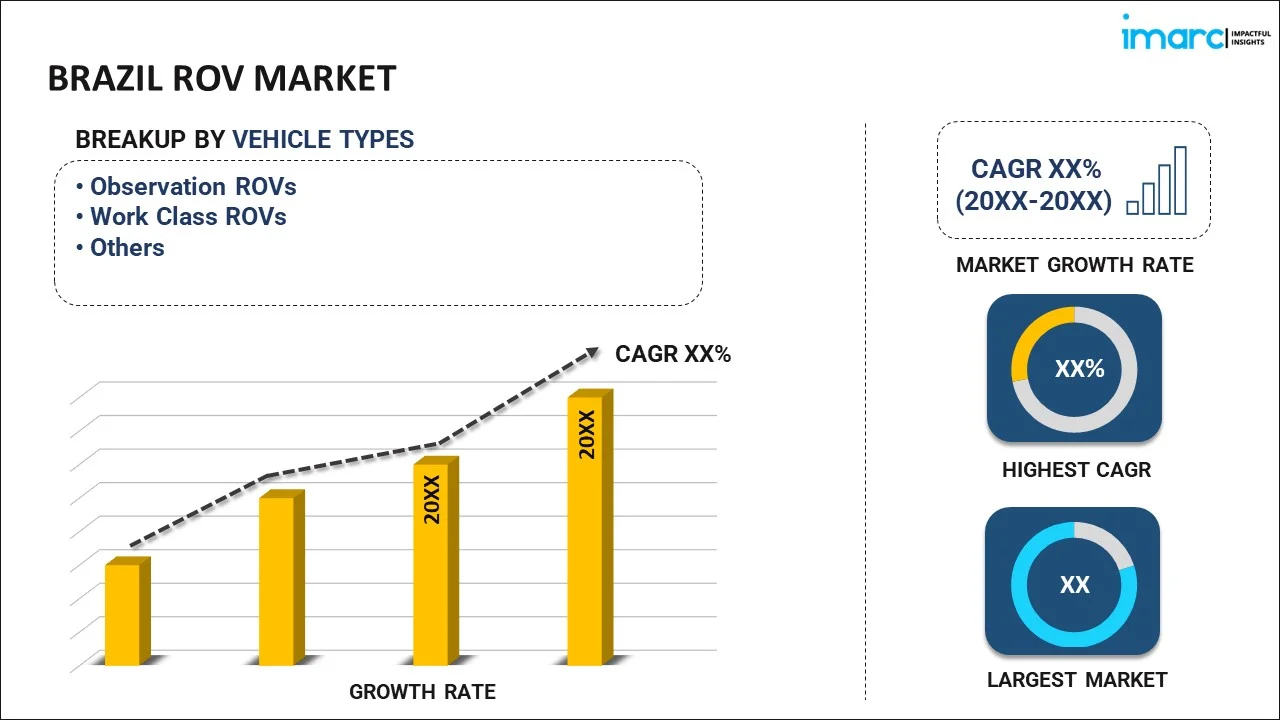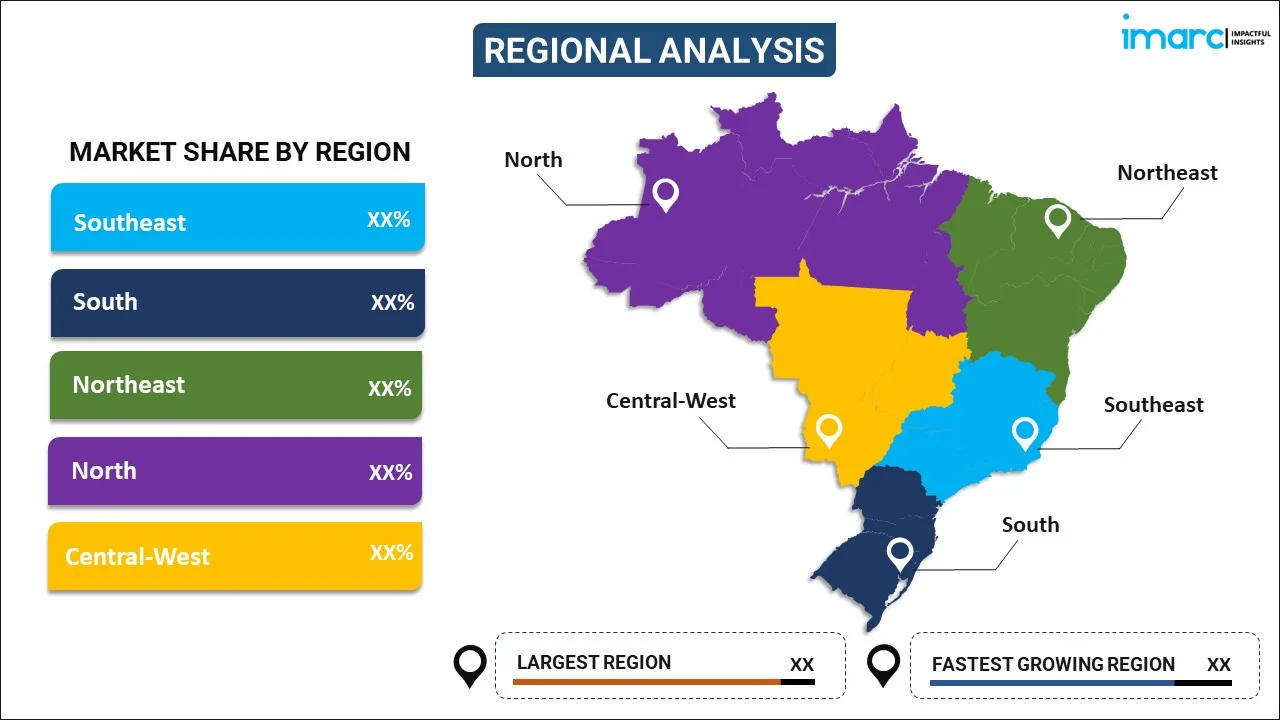
Brazil ROV Market Report by Vehicle Type (Observation ROVs, Work Class ROVs, and Others), Application (Oil and Gas, Defense, and Others), and Region 2025-2033
Market Overview:
Brazil ROV market size reached USD 52 Million in 2024. Looking forward, IMARC Group expects the market to reach USD 137 Million by 2033, exhibiting a growth rate (CAGR) of 11.4% during 2025-2033. The increasing demand for oil and gas, the exploration of deeper offshore reserves, the rising use of ROV for inspecting and maintaining underwater structures such as bridges, dams, and pipelines, the growing utilization of ROV in the scientific community for oceanographic research, marine biology studies, and underwater archaeology, and the expansion of research activities in deep-sea ecosystems are some of the factors propelling the market.
|
Report Attribute
|
Key Statistics
|
|---|---|
|
Base Year
|
2024
|
|
Forecast Years
|
2025-2033
|
|
Historical Years
|
2019-2024
|
|
Market Size in 2024
|
USD 52 Million |
|
Market Forecast in 2033
|
USD 137 Million |
| Market Growth Rate 2025-2033 | 11.4% |
A remotely operated vehicle (ROV) is an unmanned, remotely controlled submersible for underwater exploration and operations. Typically tethered to a support vessel, ROVs are equipped with cameras, sensors, and manipulator arms, enabling them to perform various tasks in challenging underwater environments. ROVs play a pivotal role in industries such as oil and gas, where they are deployed for subsea inspections, maintenance, and repair of offshore infrastructure, reaching depths often inaccessible to human divers. ROVs contribute to scientific research in the marine sector, conducting deep-sea explorations and studying underwater ecosystems. Additionally, ROVs are employed in defense applications for tasks like mine countermeasures and underwater surveillance. Their versatility extends to installing and maintaining telecommunications cables, where ROVs aid in laying and repairing submarine fiber-optic cables. Continuous advancements in ROV technology, including improved maneuverability, enhanced imaging systems, and increased operational depths, underscore their significance in various industries, making them indispensable tools for tasks ranging from scientific exploration to critical infrastructure maintenance in the depths of our oceans.
Brazil ROV Market Trends:
The market in Brazil is majorly being driven by the expansive offshore oil and gas reserves in deep-water fields such as the pre-salt layer. This, in turn, is increasing the demand for sophisticated subsea technologies for exploration and maintenance. Furthermore, the country's rich maritime resources and the increasing focus on marine research and exploration are contributing to the demand for ROVs. With scientific institutions and organizations are utilizing ROVs for oceanographic studies, marine biology research, and underwater archaeology, it driving the growth of ROV applications in scientific exploration. Moreover, as Brazil is continuing to invest in expanding its telecommunications infrastructure, there is a growing need for ROVs to assist in the installation and maintenance of submarine fiber-optic cables connecting the country to the global network. This is becoming increasingly vital as high-speed internet connectivity is essential for domestic and international communications. Besides, the defense sector is also contributing to the growth of the ROV market, where these unmanned vehicles are being employed for maritime security purposes, including mine countermeasures and surveillance operations. Additionally, advancements in ROV capabilities, such as increased depth ratings, improved sensors, and enhanced maneuverability, are attracting industries across Brazil. As companies are seeking more efficient and advanced tools for underwater operations, the adoption of cutting-edge ROV technologies is further fueling market growth. Governmental initiatives and regulations aimed at sustainable offshore exploration and environmental monitoring are contributing to the demand for ROVs equipped with advanced sensing capabilities.
Brazil ROV Market Segmentation:
IMARC Group provides an analysis of the key trends in each segment of the market, along with forecasts at the country level for 2025-2033. Our report has categorized the market based on vehicle type and application.
Vehicle Type Insights:

- Observation ROVs
- Work Class ROVs
- Others
The report has provided a detailed breakup and analysis of the market based on the vehicle type. This includes observation ROVs, work class ROVs, and others.
Application Insights:
- Oil and Gas
- Defense
- Others
A detailed breakup and analysis of the market based on the application have also been provided in the report. This includes oil and gas, defense, and others.
Regional Insights:

- Southeast
- South
- Northeast
- North
- Central-West
The report has also provided a comprehensive analysis of all the major regional markets, which include Southeast, South, Northeast, North, and Central-West.
Competitive Landscape:
The market research report has also provided a comprehensive analysis of the competitive landscape in the market. Competitive analysis such as market structure, key player positioning, top winning strategies, competitive dashboard, and company evaluation quadrant has been covered in the report. Also, detailed profiles of all major companies have been provided.
Brazil ROV Market Report Coverage:
| Report Features | Details |
|---|---|
| Base Year of the Analysis | 2024 |
| Historical Period | 2019-2024 |
| Forecast Period | 2025-2033 |
| Units | Million USD |
| Scope of the Report | Exploration of Historical and Forecast Trends, Industry Catalysts and Challenges, Segment-Wise Historical and Predictive Market Assessment:
|
| Vehicle Types Covered | Observation ROVs, Work Class ROVs, Others |
| Applications Covered | Oil and Gas, Defense, Others |
| Regions Covered | Southeast, South, Northeast, North, Central-West |
| Customization Scope | 10% Free Customization |
| Post-Sale Analyst Support | 10-12 Weeks |
| Delivery Format | PDF and Excel through Email (We can also provide the editable version of the report in PPT/Word format on special request) |
Key Questions Answered in This Report:
- How has the Brazil ROV market performed so far and how will it perform in the coming years?
- What has been the impact of COVID-19 on the Brazil ROV market?
- What is the breakup of the Brazil ROV market on the basis of vehicle type?
- What is the breakup of the Brazil ROV market on the basis of application?
- What are the various stages in the value chain of the Brazil ROV market?
- What are the key driving factors and challenges in the Brazil ROV?
- What is the structure of the Brazil ROV market and who are the key players?
- What is the degree of competition in the Brazil ROV market?
Key Benefits for Stakeholders:
- IMARC’s industry report offers a comprehensive quantitative analysis of various market segments, historical and current market trends, market forecasts, and dynamics of the Brazil ROV market from 2019-2033.
- The research report provides the latest information on the market drivers, challenges, and opportunities in the Brazil ROV market.
- Porter's five forces analysis assist stakeholders in assessing the impact of new entrants, competitive rivalry, supplier power, buyer power, and the threat of substitution. It helps stakeholders to analyze the level of competition within the Brazil ROV industry and its attractiveness.
- Competitive landscape allows stakeholders to understand their competitive environment and provides an insight into the current positions of key players in the market.
Need more help?
- Speak to our experienced analysts for insights on the current market scenarios.
- Include additional segments and countries to customize the report as per your requirement.
- Gain an unparalleled competitive advantage in your domain by understanding how to utilize the report and positively impacting your operations and revenue.
- For further assistance, please connect with our analysts.
 Inquire Before Buying
Inquire Before Buying
 Speak to an Analyst
Speak to an Analyst
 Request Brochure
Request Brochure
 Request Customization
Request Customization




.webp)




.webp)












